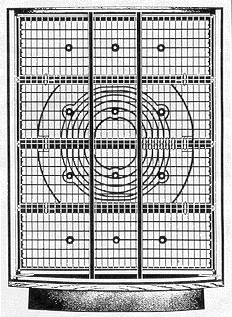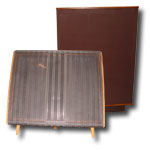The Quad ESL63, successor to the Amazingly successful Quad ESL has been in production since the early 80's. It uses a sectionalized panel approach like the original ESL, but unlike the Original, all the stator spacings are the same, and the different audio frequencies are not divided up amongst the different regions of the speaker. However the speakers is divided into regions in the form of concentric rings (see diagram). The audio signal is fed to the concentric rings through a delay line. The signal reaches the innermost ring first and then progresses to the next outer ring. This technique makes the flat panel radiate a wave front that is similar in geometry to a point source located a short distance behind the speaker.
Quad ESL63 Diagram

While the ESL63 panels are mechanically more simple; ignoring the delay line, the speaker can be thought of as a single panel vs. the original's three panels, and crossover network. But this mechanical simplicity paradigm is not reflected in the electrical side of the speaker. The audio signal must not only go through a step-up transformer, but it must also go through a large tapped choke and capacitor delay line.
Unlike the original ESL, this speaker is still in production. At the time of this writing, the retail price for a pair of the ESL63's is $6000 (US). However they can be obtained used in the $1500-$2500 price range. Are they worth 2 to 3 times the price of a used pair of original ESL's? That has been a contentious issue amongst Quad speaker owners. My experience is that the ESL63 looses a little bit of that amazing transparency that the Quads are known for. When listening to the original ESL's, particularly with simple acoustic recordings and voice, they portray a sense of the artists being actually in front of you like no other speaker I have heard. The ESL63's come very close, but there is always a slight feeling that this is a speaker feeding you this information.
But The ESL63's do outperform the original ESL's at the frequency extremes. And the 63's have a very slightly more balanced and smooth frequency response. They also are more robust, if loudness is a requirement, the 63's would be a better choice.Which is the better speaker? If they were the same price, that would be a very hard call, but with the ESL63's being 2-3 times the price of the originals, my reccomendation is to stick with the original. However, I haven't spent a lot of time with the ESL63's, so my opinion could change.
I currently do not own a pair, due to their cost. I am patiently waiting to find a set that have been damaged or need repairs. If you have such a set and would like to sell them, I'll entertain offers.
Below you will find a series of references and pictures pertaining to the Quad ESL63. This information was graciously provided by Tom Howe. Thanks a bunch!
Schematics & References:Photos:
Graphs:ESL63 Links:
|

